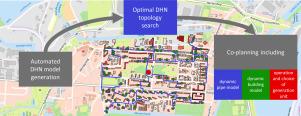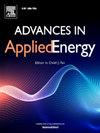District heating network topology optimization and optimal co-planning using dynamic simulations
IF 13.8
Q1 ENERGY & FUELS
引用次数: 0
Abstract
District heating networks play a critical role in the transition of the heating supply of buildings to renewable sources. The transition from coal-fired or gas-fired generation units to heat pumps requires new planning methods for district heating networks, since the efficiency of a heat pump is affected strongly by the supply temperature of the district heating network. Therefore, a co-planning approach including the operation of the district heating network in the planning process is required. This paper presents a novel co-planning approach consisting of two steps. First, an optimal district heating network topology is generated from real geo-referenced data. To determine the optimal topology, a new algorithm designed specifically for district heating networks is presented. Next, a simulation model is automatically generated from the respective topology. An optimization is used for the co-planning approach to select an optimal generation unit, find the optimal supply temperature, and dimension the pipes of the district heating network. In contrast to conventional district heating network planning procedures, the optimization includes a full-year dynamic simulation of the district heating network. The result of the planning process is a full y parameterized district heating network with a matching supply temperature. Furthermore, the use of simulation models allows the results to be reused for sensitivity analyses. This is illustrated by examining the selection of generation units under different price scenarios.

基于动态仿真的区域供热网络拓扑优化与最优协同规划
区域供热网络在建筑向可再生能源供热的过渡中发挥着关键作用。从燃煤或燃气发电机组过渡到热泵需要新的区域供热网络规划方法,因为热泵的效率受到区域供热网络供应温度的强烈影响。因此,在规划过程中需要采用包括区域供热网络运行在内的共同规划方法。本文提出了一种由两个步骤组成的新型协同规划方法。首先,根据实际地理参考数据生成最优区域供热网络拓扑结构。为了确定最优拓扑,提出了一种专门针对区域供热网络的新算法。接下来,从各自的拓扑中自动生成仿真模型。采用优化的协同规划方法,选择最优发电机组,确定最优供热温度,确定区域供热管网的管道尺寸。与传统的区域供热网络规划程序相比,优化包括区域供热网络的全年动态模拟。规划过程的结果是一个具有匹配供应温度的全参数化区域供热网络。此外,模拟模型的使用允许结果被重新用于敏感性分析。这可以通过检查不同二氧化碳价格情景下发电机组的选择来说明。
本文章由计算机程序翻译,如有差异,请以英文原文为准。
求助全文
约1分钟内获得全文
求助全文

 求助内容:
求助内容: 应助结果提醒方式:
应助结果提醒方式:


